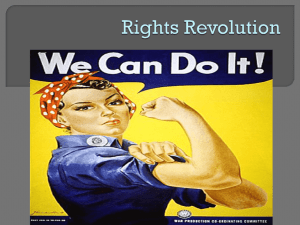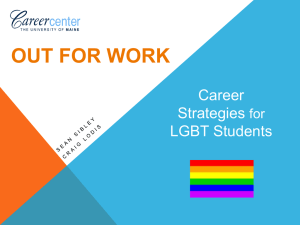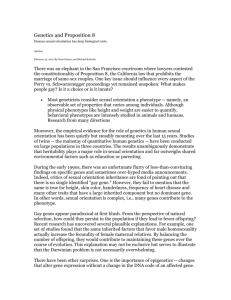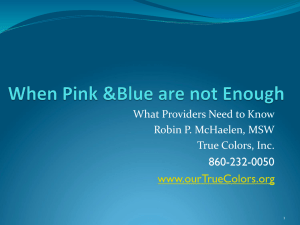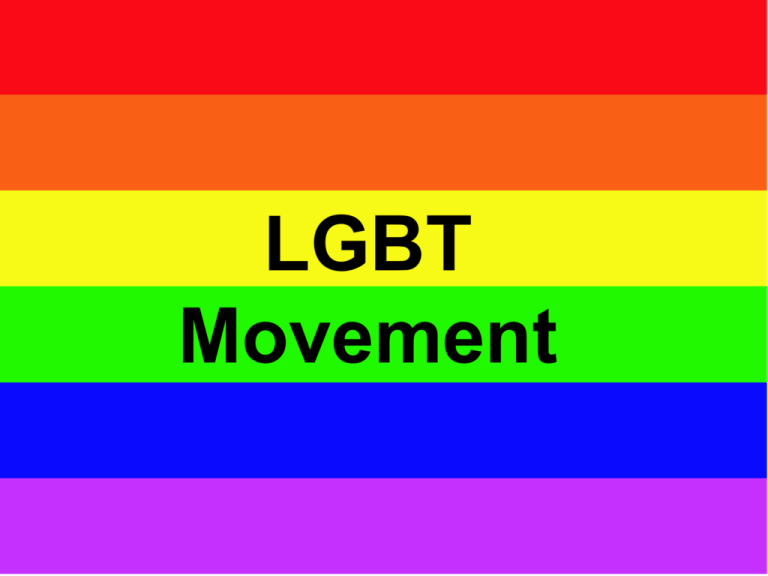
LGBT
Movement
LGBT movement topics
I. History and Impact of the
Movement
II. Gay Marriage
III. Gay’s in the Military
IV. Transgender Issues
History & Impact
of the Movement
1940s -1950s
Targeting of Businesses: the closing of gay bars and businesses that promoted social gathering
of the gay community
Anti-gay partner laws: sodomy laws
Employment Rights infringement
Black List: sparked a conservative mindset that promoted fear and aggression towards norm
deviations
FBI moral perversion investigation: invasion of privacy and harassment
Federal employment restrictions: Eisenhower dismisses “sexually perverse” federal employees
Kinsey Reports: begins open discussion about human sexuality and begins to fight stereotypes
including homosexuality.
1960s
Jose Sarria: Runs for San Francisco city supervisor
Stonewall Riot: spurs a more forceful stand against
discrimination
1970s
APA removes homosexuality from mental illness definitions: begins a change
in stereotypes among healthcare professionals
Anita Bryant protest: Florida Orange Juice spokes person fights against gay
liberation on the side of moral preservation
Florida bans gay adoption
Harvey Milk: Elected on San Francisco board of supervisors
1980s
First report of AIDS: starts a national fear that points to gay lifestyle as the catalyst. Turns gay community
in to a leper community.
AIDS quilt project: brings the effects and importance of AIDS to public view. This helps increase public
awareness as well as pushes for government funding and aid.
ACT UP group formed: Fights the misconceptions regarding AIDS and fights for AIDS prevention as well
as government funded research
1990s
Los Angeles riots
American Medical Association: opposes treatment of homosexuality as it is not seen as needing a “cure”
Employment Non-Discrimination Act defeated in US Senate
Impact of the LGBT Movement
Argument 1: The lesbian, gay, bisexual and transgender (LGBT) movement has made many
positive strides through the passing of nondiscrimination laws.
•The first law in the U.S. prohibiting discrimination on the basis of sexual orientation was passed in
1972, in the city of East Lansing, Michigan.
•The first law prohibiting anti-transgender discrimination was passed in 1975, in Minneapolis,
Minnesota.
•At the local level, sexual orientation discrimination has been banned in more than 200 U.S. cities
and counties.
•Discrimination against transgender people has been banned in over 70 U.S. cities and counties.
State and Local Jurisdictions Lead
the Way
Argument 2: Federal law does not protect LGBT people.
•EDNA: In 1994, the Employment Non-Discrimination Act of 1994 was in Congress. While this bill
received much more support from the civil rights community and other sponsors, it failed to pass by a
close 49-50 vote.
•May 1998: President Bill Clinton issued Executive Order 13087. This order issues protection for LGBT
people by prohibiting discrimination in federal civilian employment on the basis of sexual orientation.
•Because there isn’t federal support, over half of the U.S. population in 2005 (156 million people) can be
fired, evicted, or denied places of public accommodation because of sexual orientation.
•Millions of transgender people also remain vulnerable as well.
Argument 3: There is increasing growing support among the public concerning the protection of LGBT people.
•2003 Gallup Poll: Nearly 9 in 10 Americans support nondiscrimination of sexual orientation.
•A 2002 study by the Human Rights Campaign shows that 3 in 5 respondents support transgender nondiscrimination laws.
•Polls show that most Americans still oppose homosexuality. In June 2002, a Los Angeles Times poll stated that two out of three
respondents believe that sexual relations between two people of the same sex is wrong.
•“In the 1990 General Social Survey (GSS), 76 percent of respondents said that homosexual relations were ‘always wrong’. In the 2000
GSS, that number decreased 59 percent.”
•Factors that shape views of homosexuality are based on a gender belief system:
the assumption that what is not “feminine” must be “masculine” and vice versa
•Support for equal job rights for gays and lesbians: 1977-2002
•1977: 56 percent favored equal job rights
•2002: 86 percent favored equal job rights
•Attitudes regarding the cause of homosexuality: 1977-2002
•1982: 52 percent of Americans polled thought same-sex attraction was due to
upbringing
•2002: more Americans believed that a person is born homosexual rather than
environment causing their sexual orientation (40 percent versus 36 percent)
Argument 4: Nondiscrimination laws are necessary for the protection of LGBT people.
•1997 General Accounting Office Report: Despite 9 states having passed sexual orientation
nondiscrimination laws, all continued to report sexual orientation discrimination cases every year.
•2001: In a statewide survey of lesbian, gay, and bisexual New Yorkers, 54% of respondents had
experienced discrimination in employment, housing, or public accommodation since 1996; 8% were fire
based on their sexual orientation. 27% of respondents reported being called derogatory names such as
“faggot” and “dyke” in the workplace.
Argument 5: State and local laws remain unstable.
•Dade County, Florida: Anita Bryant’s “Save Our Children” Campaign: One of the earliest and most
infamous groups that repealed Dade County, Florida’s sexual orientation nondiscrimination ordinance. In
the 1970s, this led to a series of anti-gay ballot measures, which also swept into the late 1980s and 1990s.
•There have been over 100 anti-gay ballot initiatives over the past three decades.
•In some cases, the scope of the backlash went beyond the initial nondiscrimination law that was passed.
For example, in 1992, voters in Colorado passed Amendment 2, which repealed all existing state and
local anti-discrimination laws.
•Since then, in 2007, the state of Colorado banned discrimination based on sexual orientation and gender
identity/expression.
Argument 6: Grassroots organizations and LGBT groups are behind the progress that has been
made over the past three decades.
•In the past ten years, nearly 50 percent of the statewide sexual orientation nondiscrimination laws and 80
percent of statewide transgender nondiscrimination laws were passed. Grassroots organizations and
LGBT groups in different states have banned together to make this possible.
•Transgender activists and allies have worked together to pass laws which make transgender people more
visible in society.
•One positive result of the failure of Congress to pass same sex marriages has resulted in major national
LGBT advocacy organizations to become more inclusive of transgender people and supportive of federal
nondiscrimination legislation that is transgender-inclusive.
References
Avery, Alison. (2007) America's Changing Attitudes toward Homosexuality, Civil Unions, and
Same-Gender Marriage: 1977-2004 Social Work v. 52, no. 1
Suffredini, Kara S. (2005). What a Difference a Decade Makes: Lesbian, Gay, Bisexual and
Transgender Nondiscrimination Law and Policy in the United States. The Diversity
Factor, 13(1), 18-24.
(2003). Homosexuality. Contexts, 2(2), 58.
VH1 The Sex Revolution Documentary,Social Movement Growth, Domain Expansion, and
Framing Processes: The Gay/Lesbian Movement and Violence against Gays and
Lesbians as a Social Problem Author(s): Valerie Jenness , Stonewall by Martin
Duberman, The World Turned by John D’Emilio
The National Gay and Lesbian Task Force. (2008). [Graph illustration Nondiscrimination
Laws Map, July 31, 2008]. Retrieved from
http://www.thetaskforce.org/downloads/reports/issue_maps/non_discrimination_7_08_c
olor.pdf
Gay
Marriage
Equality
All people should have the same
rights and liberties that all citizens of the
United States have.
GLBT persons are not second class
citizens, separate, or segregated people
1,049 protections, benefits, and
responsibilities extended to married
couples under federal law
14th Amendment of the US Constitution
Discrimination
What is Discrimination?
States protect married
couples in important ways,
hospital visitation, right to
inherit, medical decisions in
an emergency; all these are
denied GLBT persons
There are some religions that
celebrate or accept GLBT
marriages, to have them be
classified as illegal or
unconstitutional is impinging
on their freedom of religion
GLBT Relationships are Immoral
Leviticus 18 & 20 labels
homosexuals as abomination
and sentences them to the
penalty of death
Who else is labeled
abomination in the same book?
Who else should be sentenced
to the penalty of death?
Point to make?
Arguments against Gay Marriage
Same sex couples provide a
bad environment for
raising a child
The child will turn
out gay
Gay people are all
pedophiles
Repeated studies show that it
is love and care that are
central to raising children
Children of GLBT couples
do not have higher
incidences of a GLBT
lifestyle
Majority of convicted sex
offenders are heterosexual
males*
Where are we now?
Banned States
Alabama Alaska Arizona
Arkansas California
Colorado Florida Georgia
Hawaii Idaho Kansas
Kentucky Louisiana
Michigan Mississippi
Missouri Montana
Nebraska Nevada North
Dakota Ohio Oklahoma
Oregon South Carolina
South Dakota Tennessee
Texas Utah Virginia
Wisconsin
Legal States
Connecticut
Iowa
Maine (Effective
09/14/09
Massachusetts
New Jersey (as civil
union)
Rhode Island
Vermont
Washington (as
Domestic partners)
Under a handglass
Many people have concerns about the
intense scrutiny given gay marriage and of
the consequences of fighting for marriage
equality
Language and ideology behind the gay marriage issue may
be too narrow
Nuclear Family? To fit in or not to fit in
All GLBT couples as permanent, monogamous, and desiring
of a nuclear family structure?
Legal recognition for a wide variety of relationships should be
available, as well as access to all to government support
programs
Gays in
the Military
Argument
The “Don’t Ask, Don’t Tell” policy is not
imperative for national security,
operational readiness, and is out-dated.
This policy discriminates not only
homosexuals but women as well. The
U.S. military undermines its credibility by
ceasing to cite other foreign militaries
when the anecdote no longer conforms to
the argument of the United States.
Don’t tell:
Policy Continued
A service member can be investigated
and/or administratively discharged only if
she/he:
States that he or she is lesbian, gay, or
bisexual
Engages in physical contact with someone of
the same sex for the purposes of sexual
gratification
Marries, or attempts to marry, someone of
the same sex
Investigation
Only a service member’s
commanding officer may
initiate an inquiry into
homosexual conduct.
In order to begin an inquiry,
the commanding officer must
receive credible information
from a reliable source that a
service member has violated
the policy.
History
1981-DoD makes homosexual conduct grounds for
discharge
1994-Clinton tries to lift the ban on gays in the military
Congress threatened to establish the ban as federal law
so Clinton delayed the lift
Six months later-Clinton and Congress passed the
National Defense Authorization Act, commonly referred
to as the “Don’t Ask, Don’t Tell” policy
2009-Obama states he will repeal the “Don’t Ask, Don’t
Tell” policy to allow gays in the military
President Obama States….
Discrimination of any
type should be
prohibited, even in the
military.
He will work with
military leaders to
repeal the current
“Don’t Ask, Don’t Tell”
Policy, to allow gays
in the military.
Gender Norms in the Military
The “Good Soldier”
Heterosexual gender norms
Stereotypical male qualities: aggressive, violent,
unemotional
Opposite of the “Good Soldier”
Female qualities: nurturing, sympathetic, relational
Woman threaten the male bonding experience
necessary to reinforce male characteristics and
produce “good soldiers”
Gender Norms continued
Heterosexual Norms Reinforce Male Bonding
Most important aspect of male bonding, thus
homosexuals are outsiders
Hyper-masculinity is Primary for Combat
Promoted as necessary to produce an effective
“good soldier” for combat
Military Readiness
Homosexuals do not damage morale, discipline,
and good order in those countries that have
open service.
24 nations allow homosexuals to serve in
armed forces
No study has shown any of the 24 nations that
allow homosexual soldiers to serve in uniform
has suffered a decline in performance
Israel, Great Britain, Germany, Sweden, Brazil,
and Japan experience homosexuals serving
openly as a “non-event”
Former Lieutenant Commander of the British
Navy Craig Jones offers this:
“There will always be incidents [involving] racial
prejudice or gender issues, things experienced by
society. But by and large, integration of gay soldiers
has been a hugely positive experience--and we're a
better organization for it”
However…
As of May 1, 2009, President Obama
changed his strategy and now “supports
changing Don’t Ask, Don’t Tell in a
sensible way that strengthens our armed
forces and our national security.”
Transgender Issues
Sex, Gender & Bipolarity
Sex is defined as the anatomy of a person.
The traditional view of sexes have women
and men separated, but sex in nature
recognizes intersexed and “transsexual”
individuals.
Gender is the appearance and behavior of a
person and how they see themselves.
Women typically are more accepted to
display masculine characteristics than
men.
Sexual Orientation vs. Gender
Identity vs. Sexual Identity
In regards to sexual orientation, the gender
and sex one identifies with is separate
from one another.
Sexual Orientation is defined as which sex
do you find erotically attractive:
The same sex (homo),
The opposite (hetero) or both (bi)
Sexual Identity and Gender Identity are
not the same thing as gender and sex.
For instance, ones sex can be biologically
male, yet they their sexual identity is
female. This person could wish to
physically change their body to match their
sexual identity.
Gender identity is the way one sees
themselves socially, and prefers to relate
in social aspects as the opposite sex.
Definitions/Terms
In the LGBT community, there are
ways people define themselves,
just like mini communities within a
high school:
Drag Queen: Female-emulating male,
usually campy, often (not always)
gay
Butch: Masculine-appearing person
Femme: Feminine-appearing person
Drag King: Male-emulating woman
Crossdresser: Polite term for
transvestite
Hedda Lettuce
Rupaul
Transsexual: Person whose sexual identity
is opposite to their assignment at birth.
Not all TS folk undergo ‘sex reassignment
surgery’ (SRS), for various reasons,
including personal preference. Sexual
orientation varies.
Violence Against The Transgendered
Transgendered people are often the victims
of violence.
85% of Victims are African American or
Latino.
92% of victims are biological males
presenting female traits
Most cases involve extreme violence
40% of murders happen in California and
Texas
Transgender Movement
Many in the Transgender movement feel that the
mainstream GLBT movement is under
representing the Transgendered
Some feel that for the sake of assimilation of
gays and lesbians the transgender issues are
swept under the rug
There are also some that feel the
movement is too fractured
With so many acronyms and sub groups,
there are a lot of different needs


